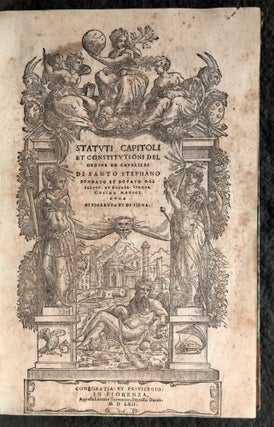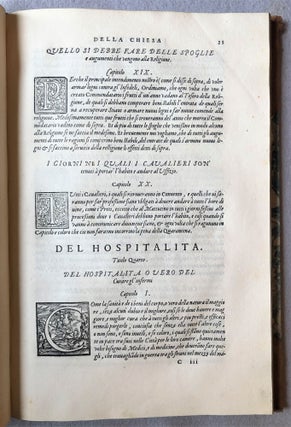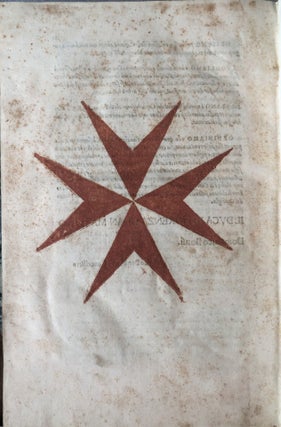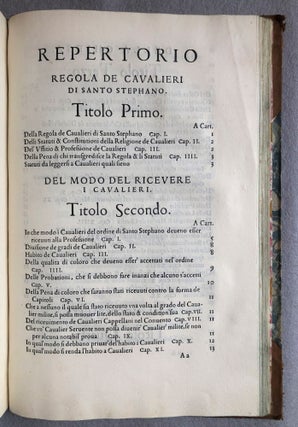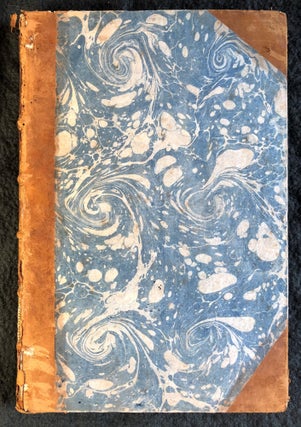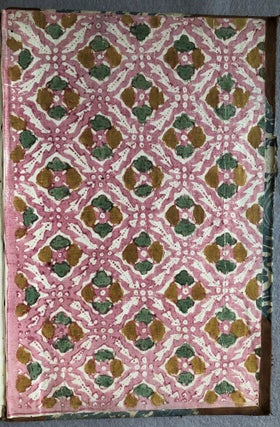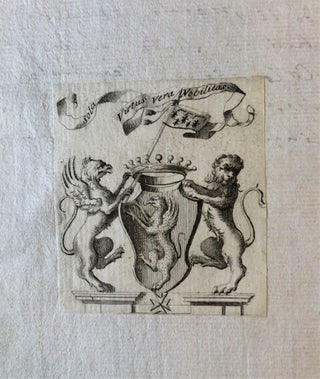Statuti Capitoli et Constitutioni del Ordine de' Cavalieri di Santo Stephano. Florence: Lorenzo Torrentino, 1562. Bound with four related documents, 1563-1566.
Folio (310 x 203 mm). Collation: 1) a4 A-L4 Aa6 M4. [8] 86, [2], [20] pages. Italic types. Title within elaborate woodcut allegorical border, several sets of historiated woodcut initials, woodcut printer’s device (the Medici arms) on verso of errata leaf (Aa6); quire Aa, the table, bound before quire M (the papal privilege). First and last quires foxed, occasional light foxing elsewhere, internal tear to fol. H3 with loss to woodcut initial on verso, small hole from paper flaw in fol. K2 with loss of 3 letters. Bound with four related imprints (see below), of which the last with a full-page cross of the order printed in red. Early 19th-century Italian half roan and marbled paper over pasteboards, spine gold-tooled with small flower tools in each compartment, the lowermost with a small star of the Order, red morocco gilt lettering-piece, probably from an earlier binding, pastedowns of block-printed paper in pink, light brown and green, edges stained blue to match the paper of the covers (worn, soiled, worming to backstrip). Provenance: engraved armorial bookplate of the Martelli family of Florence, with motto Sola virtus vera nobilitas, mounted on the front flyleaf facing the title; 19th-century inscription on front flyleaf, citing Gamba.
A Knight’s copy of the First Edition of the statutes and privileges of the Tuscan chivalric order of St. Stephen, created by Cosimo de’ Medici, first Grand Duke of Tuscany, in October 1561; bound with three updates to the statutes and an additional privilege.
To “normalize” the transition of Florence from a city-state republic to what was essentially a monarchy, Cosimo had repeatedly tried to establish a religious military order, along the lines of the Knights of Malta, but had been thwarted by papal politics. It was only with the accession of his distant cousin Pope Pius IV (Giovanni Angelo Medici di Marignano) that he was finally able to establish the order, appointing himself as its first Grand Master. Although it was based on the Benedictine rule, the order’s charge was resolutely military. Its name commemorated two battles which had consolidated Medici power, both of which occurred on August 2, the feast day of St. Stephen: the Battle of Montemurlo in 1537, in which the Grand Duke defeated republican insurgents, and the Battle of Marciano in 1554, in which Florence (backed by Spain) defeated Siena (backed by France). The new order’s primary purpose was to combat the (mostly Turkish) pirates who plagued the Mediterranean and threatened the Medicis’ newly built port at Livorno, and to join the Christian wars against the Ottoman Turks, and thus attract fame and prestige to Tuscany and its Medici rulers. In this the Order of Saint Stephen would succeed, participating, for example, in the siege of Malta in 1565, and the Battle of Lepanto in 1571. The seat of the order was in Pisa. “In its palazzo, designed by Vasari, along with its church, soldiers found a veritable naval academy which provided them with all the training that they required” (Treccani., transl.). It was only after the accession of the Habsburgs to the Tuscan Duchy in 1737 that the order’s military charges were rescinded, and it became a mere symbol of social status, which it remained, after a brief suppression during Napoleonic rule, until its final abolition with the unification of Italy in 1859.
The Tuscan order’s statutes were modeled on those of the Order of Malta. Their written formulation, praised for the elegance of the prose, may have been the work of jurisconsult Lelio Torelli, first secretary of the Grand-Duke (vide Gamba). Extremely precise, the statutes are divided into 17 parts, covering the fundamental rules governing the knights (Charity, Chastity, and Obedience), rules of admission to the order, its hierarchy, uniforms, etc.; religious ceremonies and obligations; the order’s hospital and treatment of the sick; finances; the general assembly; administration and government; duties and prerogatives of the Grand Master, prior and other officers; elections; vacancies and disposal of the possessions of deceased knights; and prohibitions and punishments. This last section describes the knights’ duty to fight only the Infidel and never to get involved in intra-Christian conflicts, and prohibits giving safe passage to pirates, declaring a truce without permission of the Grand Master, appearing in public out of uniform, consorting with prostitutes or keeping mistresses, general rowdiness, duels, swearing, beating up civilians, or otherwise harassing the population. One of the usual punishments was a 40-day period of isolation, known as “la quarantena.”
Handsomely printed at the Ducal press of Lorenzo Torrentino, the edition is ornamented with numerous woodcut initials and an allegorical title border showing Athena and Artemis on the columns, three muses or goddesses flanked by the Medici arms atop the entablature, the Medici emblems of a falcon holding a ring and a tortoise bearing a sail at the base of the columns, and below the title a scene of a river god reclining before scattered attributes of Medici power (religious and secular), before a background of ancient ruins (of Florence?) and Tuscan hills.
Bound with:
1) Privilegia, et Facultates ab Illustrissimo, et excellentissimo D.D. Cosmo Medices Florentiae, et Senarvm Dvce Religioni, & militibus Sancti Stephani concessa. 1565. Florence: sons of L. Torrentino & associates of Carlo Pettinari, 1566.
[2] leaves. Torrentino’s large woodcut device on title, woodcut initial. Roman type.
2) Al Nome dello Omnipotente Dio, et del Beato S. Stephano Papa... A Di XIIII. di marzo MDLXII. Dichiaratione sopra alcuni Capitoli, & Statuti della nostra Religione, dichiarata dall’ Illustriss. & Eccellentiss. S. il S. Cosimo de Medici Secondo Duca di Fiorenza, & di Siena ... Florence: sons of L. Torrentino, 1563.
[4] leaves. Small Medici / printer’s woodcut device on title and the large device on final verso (recto blank), 2 woodcut initials. Italic type.
Contains clarifications and additions, including one to Chapter II of the first section of the 1562 Statutes, “Regole dei Cavalieri,” which states that each soldier may have only one donna (Grand Master Cosimi I was a model of marital fidelity, unusually for the time); the relevant paragraph here specifies that remarriage after the death of one’s spouse is permitted, including to non-virgins, i.e., widows.
3) ... Dichiarazioni, Statuti, Riformazioni, Addizioni, del Gran Maestro, & Capitolo generale dell’anno 1565. Florence: sons of L. Torrentino & company, 1565.
[6] leaves, a single quire signed B. A different small Medici device on title, initials, bandeaux. Italic type. Not thus in OCLC, not in BMC, possibly an offprint or extract.
4) ... Statuti, Ordini, Riformazioni, & addizioni del Capitolo Generale dell’ anno. 1566. Florence: sons of L. Torrentino & Carlo Pettinari, 1566.
11, [1] pp. Woodcut small device on title, initial, bandeaux, and the large eight-point cross of the Order printed in red on final verso.
This copy was bound for and belonged to the prominent Martelli family of Florence, who could boast a “founding membership” in the Ordine di Santo Stefano, and who continued to fill its ranks into the 18th century (cf. Marchesi, La Galeria dell'onore, ove sono descritte le Memorie del Sagr'Ordine Militare di S. Stefano P. e M. e de suoi Cavalieri, Forli 1735, vol. 1, passim). The occasional attribution of the bookplate to Giuseppe Maria Martelli (1678-1741), archbishop of Florence from 1722 to 1740, is not certain, but by the 19th century the Martelli family library was considered one of the most important private libraries of Florence. Cf. A. Bertarelli and D. H. Prior, Gli ex libris italiani (Milan 1902), p. 247 (dating to ca. 1730); J. Gelli, 3500 ex libris italiani (Milan 1908), pp. 245–246 and fig. 462 (misdating to ca. 1830).
References: EDIT-16 CNCE 10515; Gamba, Serie dei testa di Lingua (1839), 1660 (with quire M); Adams, Catalogue of Books Printed on the Continent of Europe 1501-1600 in Cambridge Libraries (1967) S-1832 (without quire M); Moreni, Annali della tipografia fiorentina di Lorenzo Torrentino (1811), p. 205 (”questa stupenda edizione”). On the Order, cf. Treccani, Enciclopedia Italiana (1936, online), art. “Santo Stefano, Ordine di.” and “The Knights of St Stephen of Tuscany” in website “The Mad Monarchist.” For the additions, see BM/STC Italian, p. 647.
Price: $2,750.00


